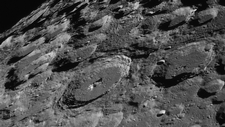Moon: Physical Characteristics
Supporting

TEKS Objective
The student is expected to identify and compare the physical characteristics of the Sun, Earth, and Moon.
Essential Understanding
The student knows that there are recognizable patterns in the natural world and among the Sun, Earth and Moon system.
Science Background
Earth's Moon vs. Earth: NASA (website) - Use this NASA data table to compare physical characteristics, orbits, rotations, etc. of the Earth and Moon. Includes links to information about other celestial bodies.
Earth's Moon vs. Earth
NASA, www.nasa.gov
Physical Characteristics: Infoplease.com (website) - Explanation of the moon’s primary features, internal structure and formation/evolution.
Physical Characteristics
Pearson Education, Infoplease, www.infoplease.com
Solar System Exploration: NASA (website) - Extensive collection of multimedia, interactive content relating to many aspects of the solar system, including Earth and the moon.
Solar System Exploration
NASA, www.nasa.gov
Moon Fact Sheet: National Space Science Data Center (website) - Detailed information about the physical characteristics of the Moon, the lunar atmosphere, and the Moon’s orbit around Earth.
Moon Fact Sheet
National Space Science Data Center, nssdc.gsfc.nasa.gov
Signature Lesson
Make a Crater: NASA Lunar Prospector (website) - Students investigate the role of an impact object’s velocity and mass to identify and compare the size of craters on Earth, the Moon and other celestial bodies in our solar system.
- Supporting Lessons
- Extensions
- Assessment Ideas
- Literature Connections
- Related
TEKS - Additional Resources
Supporting Lessons
Observing the Moon: The University of Texas at Austin McDonald Observatory(PDF) - Students make nighttime observations of the Moon and sketch its appearance.
Observing the Moon
The University of Texas at Austin McDonald Observatory, StarDate, stardate.org
The Earth and Moon: Utah Education Network (website) – This lesson compares the physical appearance of Earth and of the Moon as viewed from space.
Elaboration Lessons and Extensions
NASA Exercise - Survival on the Moon: University of Aberdeen (PDF) - Activity in which students are astronaut survivors of a crash landing on the Moon’s surface. They work in teams to decide which items to bring on their journey to rendezvous with their “mother ship.”
NASA Exercise - Survival on the Moon
University of Aberdeen, www.csd.abdn.ac.uk
Earth, Moon & Sun Classroom Activities: Morehead Planetarium and Science Center (PDF) -Teacher guide with lessons about the Moon, Earth and Sun from a Native American perspective.
Assessment Ideas
Using pictures and text, have students describe the relationship between the height of the drop point of an object and the depth of the crater formed on a surface after impact.
Literature Connections
The Moon. Simon, Seymour (ISBN-13: 978-0689835636)
Earth and Moon. Kerrod, Robin (ISBN-13: 978-1929298648)
Footprints On the Moon. Siy, Alexandra (ISBN-13: 978-1570914089)
Man On the Moon. Suen, Anastasia (ISBN-13: 978-0140565980)
Moon (Our Solar System). Meachen-Rau, Dana (ISBN-13: 978-0756504380)
The Moon. Winrich, Ralph (ISBN-13: 978-1429607254)
What the Moon Is Like. Branley, Franklyn (ISBN-13: 978-0064451857)
Additional Resources
Myths about Moon: Windows to the Universe (website) - Use stories, myths, rhymes, poetry, and games to teach students about the Moon.
Myths about Moon
Windows to the Universe, www.winsdows2universe.org
Photojournal: NASA Jet Propulsion Laboratory (website) - Huge collection of downloadable, high-resolution images of the planets.
Photojournal
NASA Jet Propulsion Laboratory, jpl.nasa.gov
The Moon: Hawai’i Space Grant Consortium (website) - Compendium of moon resources and activities, including teacher background and student pages.
The Moon
Hawai’i Space Grant Consortium, www.spacegrant.hawaii.edu
Moon: Google (website) - A view of the actual moon surface, showing where NASA astronauts on different Apollo missions landed.
TEKS Navigation
Grade 5
Need Assistance?
If you need help or have a question please use the links below to help resolve your problem.

Comments